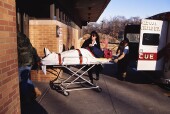
TUESDAY, Jan. 25 (HealthDay News) — Designated stroke centers seem to be saving lives, new research finds.
Patients with ischemic stroke (involving a blood clot to the brain) were more likely to get appropriate medication and survive if treated at one of these specialty centers than at a “regular” hospital, according to a study published in the Jan. 26 issue of Journal of the American Medical Association.
Reviewing records for almost 31,000 patients, the study found that stroke center patients had about a 20 percent lower risk of death over 30 days than patients treated at non-stroke centers, a difference the authors characterized as modest.
“Any statistically significant improvement in mortality, small, modest or large, is important and the 15 to 20 percent reduction is about as good as the mortality prevention efforts that we’ve seen in stroke,” said study co-author, Dr. Robert Holloway, a neurologist at University of Rochester Medical Center. “This is a fairly robust and important finding,” he added.
The Joint Commission began certifying U.S. stroke centers in 2003. They were modeled after trauma centers, and the purpose was to “create organizations and coordination of care to improve patient outcomes,” Holloway explained. “[There are] requirements that hospitals need to achieve and a process in place that hopefully will result in better outcomes over time.”
About 900 hospitals are certified nationwide, including 200 identified through state designation programs. Prior to this study, it was unknown if the centers were actually saving lives, according to background information in the study.
The researchers analyzed 2005-2006 data from a New York State database, which followed outcomes of patients after stroke. New York has its own program to designate stroke centers.
About half of the patients who had acute ischemic stroke were sent to designated stroke centers, the researchers found. After 30 days, 10.1 percent of these patients died, versus 12.5 percent of patients sent to other facilities, an absolute risk reduction of 2.5 percent.
Use of clot-busting medications was 4.8 percent for stroke center patients and 1.7 percent for patients at nondesignated hospitals, meaning patients admitted to designated stroke centers were 2.2 percent more likely to receive clot-busting medications.
Improvements were seen out to one year (as far as the database extended).
Dr. Roger Bonomo, director of stroke care at Lenox Hill Hospital in New York City, noted that the improvements “started at day 1 of the stroke center being certified,” meaning that greater improvements may be seen as more data is collected.
But the study only looked at one outcome, said another expert.
“It’s good to know that people who make an effort to deliver evidence-based and organized care are making a difference for stroke patients,” said Dr. Andrei Alexandrov, professor of neurology and director of the Comprehensive Stroke Center at the University of Alabama at Birmingham.
“The unfortunate part is that we do not have more extensive databases nationwide to look at factors other than death rate,” Alexandrov said. “Death is not the worse outcome in stroke. What we would really like to know is, are we reducing the number of people with really severe disability that leaves you bedridden? That’s the target.”
A second study in the same issue of the journal found that the incidence of stroke following bypass operations has fallen considerably over the past three decades although Americans are at higher risk than ever for having a stroke.
After peaking in 1988 at 2.6 percent, the incidence of stroke decreased 4.69 percent per year, leaving an overall stroke rate after coronary artery bypass surgery of 1.6 percent.
Medicare reports that 1.3 percent of its beneficiaries, who are mostly elderly, undergoing coronary artery bypass grafting experience a stroke each year.
The authors attributed the improvements to better surgical techniques and better pre- and post-operative care.
More information
The American Heart Association has more on stroke.

